|
|
I have reviewed several of the apps over the last year or so starting with Some interesting Apps for the iPhone Camera in the Bangkok Post, Database section last August (camerabag, Camera Zoom, Sepia Camera, Art Camera, PhotoBox and Effects Lab). I also looked at an app for creating panoramas on the iPhone, and reviewed Chase Jarvis' Best Camera app - Shoot, Edit, Share. It is Jarvis who came up with the idea that the best camera is the one you have with you, and although I carry around my Nikon D70s all the time, I am more likely to reach for the iPhone, despite my distaste for looking at an image I am taking via the screen. I far prefer a camera viewfinder for the intimacy of photographer with subject. Nonetheless, I have continued to amass these apps and the iPhone now sports a couple of screens dedicated to photography related downloads. The feature in iTunes that allows easy sorting of the apps has been a godsend here and other screen pages have apps that have related purposes, thus avoiding a frantic scroll of the pages or the slower look at the search feature. Something caught my eye the other day in an online article and that led me from a web page to the iTunes App Store and a page for a new app called Camcorder [App Store link]. Apple has been under a spotlight recently with the way the App Store processes are being carried out and appear to have made some efforts to greasing the wheels; and part of that easing has been to allow certain APIs (Application Programming Interface - interactions between hardware and software) that were restricted before. It seems that the iPhone 3G and the 2G may have been video capable all the time. Camcorder was on my hard disk within a couple of minutes and I noticed at the bottom of another photography app screen a display of what others had bought. I ended up downloading ten more apps for photography features which I will be reviewing in the Bangkok Post in the new year. Among the highlighted apps was another for video: iVideoCamera [App Store link]. A couple of days later while looking for information about the first two, I spotted iVidCam [App Store link]. Camcorder and iVideoCam were 99c each, while iVidCam was $1.99. There is also a free version, called iVidCam Free [App Store link] with restrictions). These were released on 12, 14, 17 and 18 December respectively.
What I found most frustrating about Camcorder was what to do with the video once it had been recorded. I could find no way of sending it out via email or to other services like YouTube; nor did it download into iPhoto. While Image Capture which occasionally rescues me when dealing with pictures on a camera card, or the iPhone, did not indicate that there were files available. Neither the page in the App Store, nor the developer website gave any additional assistance on this, the developer, KendiTech, whose CameraZoom I also use, has now replied to my email and tells me that they are working in an update to add this. That is a welcome announcement. It does the job OK, but video that cannot be used is as good as no video at all. An update (now version 1.2) appeared at the close of the year and that made some significant changes to handling the files in that it is now possible to export a video to the camera roll and to email video. In addition, the recording time is shown as unlimited, with resolution as 320 x 426, almost identical to the resolution of iVideoCamera. Taking a video is unchanged, but once done a click on the album panel (bottom left) reveals the videos. Saving these took 25 seconds for encoding and saving a 12 second clip, and 85 seconds for a clip of 1m 40secs. Sending that same (longer) clip by email required encoding again, so I thought it might be better to work directly from the photo roll, especially as I found that the longer clip did not work and I sent myself an empty email (I thought it had gone out quickly). However, while we can send photos by email from the photo albums, videos cannot be sent. I repeated the process, but again, no file was attached to the email, so I may have hit a brick wall here with the large file size which later appeared in iPhoto (see below) as 20.9MB. The 12 second clip -- 4MB -- worked fine (taking a lot longer for the sending) and I was able to view it on the iPhone (in Mail) or on my Mac, where I was also able to save the file. Obviolusly dealing with a photo album is easier and when I synchronised the phone, the video clips were imported into iPhoto with no problem. Camcorder has gone from a work in progress to an app that works but may still be in need of development although the signs are good in the way these first (major) improvements were implemented. Pretty good value for $0.99 really. [Amended 22 and 31 Dec. 2009.]
At the outset the interface is just like the iPhone camera with a record button at the bottom of the screen. Press this and, like Camcorder, the process begins. After a period of 1 min 11 secs the app itself cancelled the recording as it was out of memory. It then offers Save or Cancel buttons. The saving process takes a few seconds and progress bars are displayed: first video, then audio. When this is complete, a page with four options appears: Save to Camera Roll; Share Video; Watch Video; and Cancel, Record Again.
Share Video allows a number of Upload options: to YouTube, Facebook and Vimeo; as well as another Save to Camera Roll button and an Email option. This works with a short video, but the longer videos (the one of 1.11 for example) cannot be used. Once past this page, for example if one exits the app, this cannot be accessed again for that video (taking a new one also does not help). All that may be done is to enter the Camera Roll and use Copy/Paste to put the video into an email. However, that may be redundant at this stage. Whatever means I have used to get the video from my iPhone 3G onto my computer (iPhoto, email, Image Capture) has downloaded a video that cannot be viewed. In the main I have seen green or patterned screens, but not the video I took and which is viewable on the iPhone.
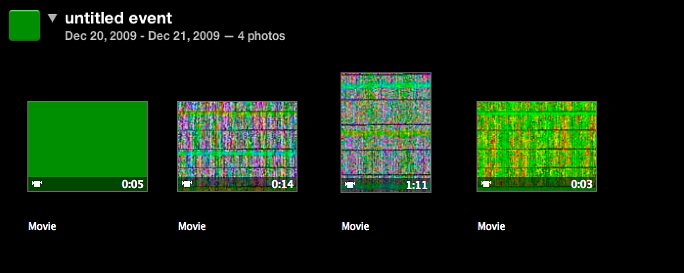
Currently, then, this is not a useful app, unless users restrict themselves to watching the videos on the iPhone only. However, the Laan Brothers at Laan Labs are aware of the problem and hopefully have a fix in hand, so it may be worth sticking with this: early days for video on the 3G iPhone and its cost is minimal.
That Library is accessed using an icon at bottom left of the opening screen. That reveals videos saved and at the bottom of the panel displaying these, there is a button to turn WiFi on or off: Off is the default. Again like iVidCam, access to such videos is via the browser on the computer which brings up a nice interface and downloading is easily effected. A neat little touch here for security is that each time the browser method is used, the port number changes. In addition, each time the wifi download is completed, we are required to turn off access. The proof of the pudding, they say, is in the eating, and it is clear that the Laan Brothers have been working hard. Both videos I created as test output worked in the Finder and in QuickTime overcoming the main criticism I had of this app before. The one (higher quality) video that I saved to the Camera Roll was imported into iPhoto correctly and also displayed properly. That they have improved data handling methods and the interface are double bonuses.
Above the Help button are four other links: YouTube Login that requires Username and Password; YouTube Defaults (for changing settings concerning the upload); Twitter Login; and an Audio ON/OFF button. With iVidCam and iVideoCam I did not use any of the upload facilities (YouTube, Twitter, Facebook, Vimeo), partly due to time limits, so focussed on basic output methods: phone to computer to see how each worked. The page on the App Store has a considerable amount of useful information concerning frame rate (3 - 7/sec), resolution (280 x 360) and restrictions. The length of a clip can be much longer with this app (the developer claims that they have made videos of up to 10 minutes) and when users complete their videos they are prompted for a file name: files are saved in MP4 format. The saving takes some time, depending on clip length. A video is then accessed using the library icon at bottom left of the main page. In the library the videos are listed with an Edit button top left for deleting unwanted files. Pressing the video entry brings up a screen with two buttons: Play Video, and Publish to YouTube. Once the video is uploaded to YouTube, the link can be shared using the Twitter feature. I have not tested this. Play Video displays the video with the phone in the landscape mode. If the phone is held on its side the video is shown sideways. Exports to the computer are also displayed like this, so it would be best to drop the clips in iMovie which has a rotate facility. Unlike iVideoCamera, there is no email feature, nor does the video appear in iPhoto or Image Capture. However, there is an equally usable transfer method: wifi. At the bottom of the Library panel is a wifi transfer item and when pressed this shows an IP number to be typed into a browser, such as 198.163.66.112:8080 -- a method used by a number of file transferring apps I have. This worked perfectly at home and the transfer was fast, directly into the Downloads folder, but in the notoriously flaky office network I have to use, this did not want to cooperate at all. The wifi there has several bad hair days a week and this does not reflect on iVidcam. The working connection at home gave me about 700KB/Sec transfer speed.
Picture quality is slightly better as expected with the resoluton change, although the digital zoom does reduce that quite a bit. That feature is effected using a slider bar at the bottom of the screen which causes some camera shake (as does pressing the start and stop butons). Exports -- I really appreciate that wifi transfer method -- are still in the portrait mode and if made in landscape need rotating 90°. QuickTime has no option for that, so it would be iMovie for most of us.
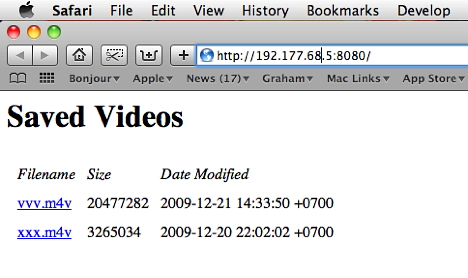
While video output from the iPhone 3Gs is of a better quality and much easier to handle, these three solutions go some of the way to letting those of us with the earlier devices (3G and 2G) to extend the capabilities in a small way and thus get extra enjoyment out of them. Tongue in cheek, these are improvements on what was available before. What is needed is some more development.
|
|

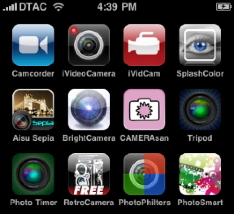 One of the interesting points about the iPhone has been the number of photography apps that have appeared for it, from special effects to filters and a number of other ways in which the user can squeeze the best out of the feature which, particularly when compared with a digital SLR device, does come up lacking in some areas.
One of the interesting points about the iPhone has been the number of photography apps that have appeared for it, from special effects to filters and a number of other ways in which the user can squeeze the best out of the feature which, particularly when compared with a digital SLR device, does come up lacking in some areas. The pages in the App Store do warn quite clearly that the video produced by both Camcorder and iVideoCam would be jerky. With that caveat accepted, they both do the task up to what was specified. A fairly reasonable video with good contrast, clear whites and a nice blue sky was quite within the cabilities of Camcorder. I made a few clips of fairly brief duration (8 secs - 22 secs), as well as a slightly longer one at 1 min 40 secs. Jerkiness is there, when panning for example and in poorer light conditions if the pan was too fast, there would be some blurring. But this is not Hollywood.
The pages in the App Store do warn quite clearly that the video produced by both Camcorder and iVideoCam would be jerky. With that caveat accepted, they both do the task up to what was specified. A fairly reasonable video with good contrast, clear whites and a nice blue sky was quite within the cabilities of Camcorder. I made a few clips of fairly brief duration (8 secs - 22 secs), as well as a slightly longer one at 1 min 40 secs. Jerkiness is there, when panning for example and in poorer light conditions if the pan was too fast, there would be some blurring. But this is not Hollywood.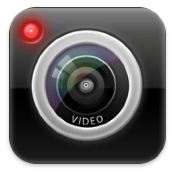 We had a little more success with
We had a little more success with 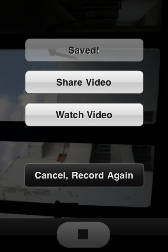
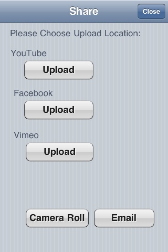
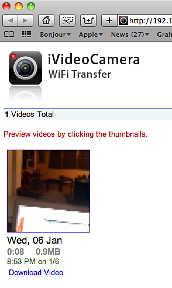 There are now two recording modes, with the high quality one at 320 x 426. When this was first selected it gave me a warning: higher quality means more resources of course. Recording is as straight forward as before and when finished several options are made available: export to camera roll; share video, which has those external upload sites listed (each requires its own form of login or authentication at least for the first time); watch video; delete video; and record again. Even without my input here, the top of the screen showed "Video Saved to Library", which indicates the library of the app and not the camera roll: that needs input from the user.
There are now two recording modes, with the high quality one at 320 x 426. When this was first selected it gave me a warning: higher quality means more resources of course. Recording is as straight forward as before and when finished several options are made available: export to camera roll; share video, which has those external upload sites listed (each requires its own form of login or authentication at least for the first time); watch video; delete video; and record again. Even without my input here, the top of the screen showed "Video Saved to Library", which indicates the library of the app and not the camera roll: that needs input from the user.
 The last app,
The last app, 